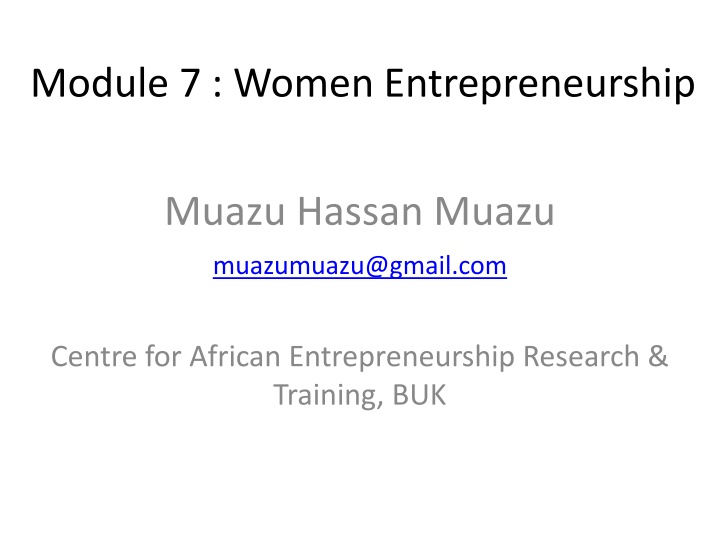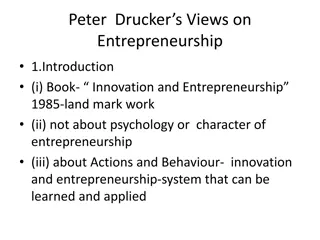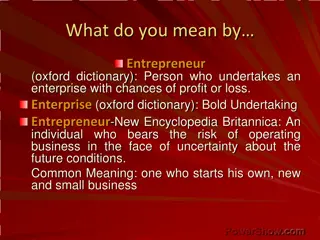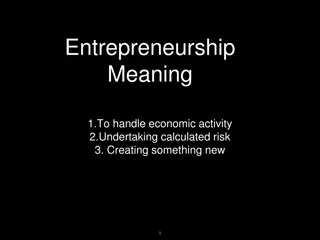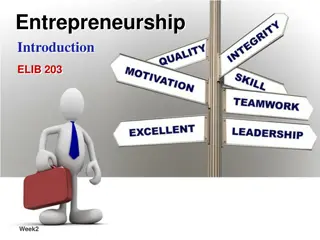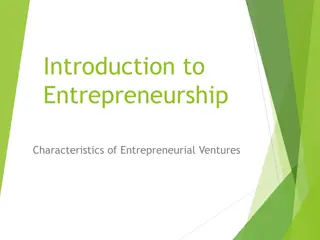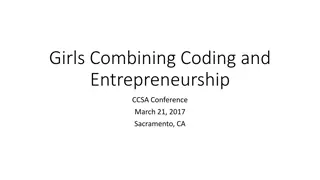Exploring Women Entrepreneurship: Characteristics, Contributions, and Barriers
Women entrepreneurship is an essential aspect of economic growth and societal change. This module delves into the concept, characteristics, motives, and barriers faced by women entrepreneurs, highlighting their contributions to the economy. Understanding the distinct nature of women entrepreneurship offers insights into leveraging their potential for innovation and job creation.
Download Presentation

Please find below an Image/Link to download the presentation.
The content on the website is provided AS IS for your information and personal use only. It may not be sold, licensed, or shared on other websites without obtaining consent from the author.If you encounter any issues during the download, it is possible that the publisher has removed the file from their server.
You are allowed to download the files provided on this website for personal or commercial use, subject to the condition that they are used lawfully. All files are the property of their respective owners.
The content on the website is provided AS IS for your information and personal use only. It may not be sold, licensed, or shared on other websites without obtaining consent from the author.
E N D
Presentation Transcript
Module 7 : Women Entrepreneurship Muazu Hassan Muazu muazumuazu@gmail.com Centre for African Entrepreneurship Research & Training, BUK
Objectives On completion of this module medical students should be able to: Discuss the concept and nature of women entrepreneurship Examine characteristics, motives, patterns & barriers to women entrepreneurship Identify the contribution of women entrepreneurs to the economy What is the way foreword
Introduction Apart from the general diversity in entrepreneurial practices, there appears to be significant differences in the characteristics of male and female entrepreneurs. Historically, entrepreneurship has been a male dominated pursuit. Although women make up more than 60 percent of the world population, they own and manage significantly fewer businesses than men. The UK Global Entrepreneurship Report found that men are around two and half times more likely to be entrepreneurs than women.
Why Study Women Entrepreneurship? Women s entrepreneurship needs to be studied separately for many reasons; Women s entrepreneurship has been recognized during the last decade as an important untapped source of economic growth. Women entrepreneurs create new jobs for themselves and others; By being different, they provide society with different solutions to management, organization and business problems as well as entrepreneurial opportunities. Women s entrepreneurial activities are not only a means for economic survival but also have positive social consequences for the women themselves and their social environment. to the exploitation of
Characteristics of Women Entrepreneurs Overall, the explanation for the behaviour of women entrepreneurs and why they are distinct is complex and multifaceted. Reasons contributing to these differences include factors such as Demographics Socioeconomic variables Subjective perceptions Cultural factors Institution
Characteristics of Women Entrepreneurs According to the UK s Global Entrepreneurship Report: In Europe & US the Peak age group at which people start businesses is 35 44 for men and 40 54 for women which suggests that having children may be a factor. On the contrary African women entrepreneurs tend to be younger than men by two or three years. This may suggest that access to entrepreneurship may be slightly easier for younger cohorts of women. Women are relatively more likely than men to believe that they cannot create any job in the next few years. Men are nearly twice as likely to think that they have the skills to start a business as a woman. Women entrepreneurs are not afraid of taking business risks and are more than twice more likely to take above average risk than their male counterparts in US.
Motivation for Women Entrepreneurship The desire to become their own boss so as to assert control Women generally do not make profit the basis for their business pursuit; rather they seek all avenues to share their business ideas with others who may benefit from their innovations. Women entrepreneurs are also motivated by philanthropic commitment to society. Desire for economic independence The need to help in providing for the children
Pattern of Businesses Owned by Women Women-owned businesses tend to be smaller, Cluster in consumer-oriented sectors Generate lower sales turnover than those owned by men Women-owned enterprises is concentrated in the services sector and jeopardizes women s prospects in high growth sectors Women generally employ smaller capital base to start their businesses, there by having lower ratios of debt financing The retail industry remains, by far, the largest field of women entrepreneurship
Barriers to Women Entrepreneurship Socio-Cultural Factors ranging from low education and skills level, multiple roles women played in the family and other cultural factors. Legal and Regulatory Environment there is no provision in the Nig. Legal system specially for women when it comes to business registration, incorporation and licensing practice. Access to Finance like any other entrepreneur, women find it difficult to access funds from the banks due to lack of managerial experience, weaker credit history, reluctance to take risk and a preference for small business size. This gap is somewhat ameliorated by the provision of micro-credit to women Sense of Self-Worth and Role-Models - lower level of confidence, a greater fear of failure and the lack of role models may be preventing some women from entering into business ownership.
Barriers con....... Networking - This is partly because women are often too shy to initiate one or society does not encourage such activities. Support Services and Other Factors - Impact of support services in business development constitutes another major challenge for women entrepreneurship. Heavy bureaucratic requirements, complex and costly business plans, high collateral requirements for credit and difficult access to technology, are some of the hindrances to starting an enterprise. These include: Limited access to necessary technologies due to lack of information and know-how, and high prices Difficulty in finding appropriate production site at competitive prices Inadequate skills in the field of production, business management and marketing Lack of skills for product diversification Inadequate infrastructure and utilities, of which inadequate transportation from rural areas and insufficient power supplies are most serious, Limited access to information
Way Foreword Gender awareness is important for policy makers and decision makers at all levels of public and private institutions. The process of policy formulation has to incorporate gender mainstreaming strategies. Ministries in charge of women affairs, SMEs development, NGOs, women s organizations and technical cooperation programmes all have important roles to play in emphasizing gender issues and creating a more enabling environment for women in enterprise.
Way Foreword con... Policy development has to address the needs of women entrepreneurs and particular policy lessons including; ensuring equal property and inheritance rights, strengthening financial education and encouraging dissemination of financial information to women, facilitating access to public support services, fostering a positive amongst women, promoting development of women entrepreneurship networks and Supporting mentoring and coaching programmes. image of entrepreneurship
Initiatives aimed at Alleviating Womens Challenges in Entrepreneurship The resolved Governments, international organizations to: Increase the participation of women in industry and all other sectors, particularly in the non-traditional areas, through access to advanced technologies; Promote, support and strengthen female entrepreneurship development; Encourage investments in environmentally safe products and in environmentally sound and productive agricultural, commercial and industrial activities and technologies; and Strengthen training opportunities for women. 4thWorld conference on that specific actions needs to be taken by nongovernmental women in Beijing 1995 organizations and
These initiatives often are tailored under the following general areas: Mainstreaming - This involves devising a plan or strategy to involve women in the development process or in specific activities. Women are also integrated in decision making at all levels; Participatory approach - This involves continuous dialogue in the course of formulating and implementing programmes that involve and affect women; and Integrated Approach - Women entrepreneurs issues and constraints are addressed in a broad perspective and in a coordinated manner. The ultimate goal is to increase the competitiveness of these women beyond what could be achieved through tackling the subject in selected or isolated manner.
